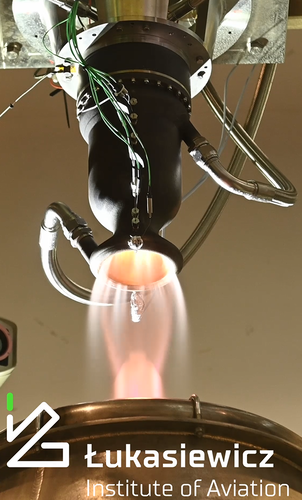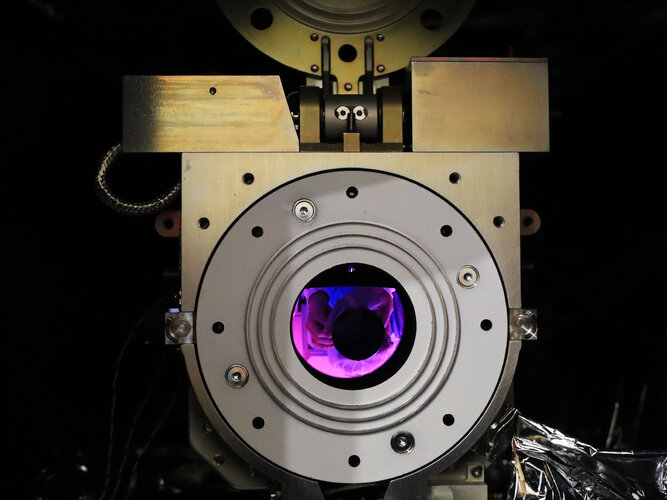
Copernical Team
Oort cloud resembles a galaxy, new study finds
 A shell of icy objects at the edge of the solar system known as the Oort cloud has a pair of spiral arms that resemble a miniature galaxy, new research suggests.
Until now, the shape of the cloud and how it is affected by forces beyond our solar system have not been largely understood. But the new research, published Feb. 16 at arXiv, says the cloud may look like a spiral disk, one of t
A shell of icy objects at the edge of the solar system known as the Oort cloud has a pair of spiral arms that resemble a miniature galaxy, new research suggests.
Until now, the shape of the cloud and how it is affected by forces beyond our solar system have not been largely understood. But the new research, published Feb. 16 at arXiv, says the cloud may look like a spiral disk, one of t Blue Ghost Mission Nears Moon Touchdown and GNSS Milestone
 Firefly's Blue Ghost Mission 1 is set to land on the Moon in less than a week with touchdown expected on Sunday March 2 after its launch on Jan 15. In preparation for descent, the spacecraft will execute its final lunar orbit maneuver on Monday, Feb 24, inserting it into a near-circular low orbit that brings it closer to the lunar surface. Approximately one hour before landing, a Descent Orbit
Firefly's Blue Ghost Mission 1 is set to land on the Moon in less than a week with touchdown expected on Sunday March 2 after its launch on Jan 15. In preparation for descent, the spacecraft will execute its final lunar orbit maneuver on Monday, Feb 24, inserting it into a near-circular low orbit that brings it closer to the lunar surface. Approximately one hour before landing, a Descent Orbit
ESA and Red Cross partnership brings space technology to humanitarian crises

The European Space Agency (ESA) and the International Committee of the Red Cross (ICRC) have signed a Memorandum of Intent (MoI) to harness space technology for humanitarian assistance worldwide. The partnership will combine ESA's space expertise with ICRC's humanitarian reach to develop space-enabled solutions that can help protect and assist communities affected by disasters and conflicts across Europe and beyond.
Vary that thrust: longer hot-fire of rocket engine demonstrator

Proba-3 stargazing to warm up for corona observations

The European Space Agency’s Proba-3 mission will create artificial solar eclipses in orbit, allowing scientists to study the Sun’s corona for longer periods of time than would be possible during eclipses observed from Earth. To test the functionality of Proba-3’s systems, researchers from the Royal Observatory of Belgium took a snapshot of a star field – in the very first image captured by the mission’s coronagraph.
Politecnico di Milano and Georgia Tech introduce new insights into asteroid deflection
 How prepared is humanity to deflect an incoming asteroid? This question is addressed in two recent studies published in *Nature Communications*, stemming from a collaboration between Politecnico di Milano, the Georgia Institute of Technology, and other global research institutions. The studies analyze the outcomes of NASA's DART (Double Asteroid Redirection Test) mission, which successfully impa
How prepared is humanity to deflect an incoming asteroid? This question is addressed in two recent studies published in *Nature Communications*, stemming from a collaboration between Politecnico di Milano, the Georgia Institute of Technology, and other global research institutions. The studies analyze the outcomes of NASA's DART (Double Asteroid Redirection Test) mission, which successfully impa China Prepares for Launch of Tianwen 2 Asteroid Mission
 China is gearing up for its first asteroid sample-return mission, Tianwen 2, which is set to launch in the coming months from the Xichang Satellite Launch Center in Sichuan province, according to the China National Space Administration (CNSA).
The space agency announced on Thursday that the robotic probe has already arrived at the launch facility. It stated that "facilities at the launch c
China is gearing up for its first asteroid sample-return mission, Tianwen 2, which is set to launch in the coming months from the Xichang Satellite Launch Center in Sichuan province, according to the China National Space Administration (CNSA).
The space agency announced on Thursday that the robotic probe has already arrived at the launch facility. It stated that "facilities at the launch c PLD Space expands global launch network with new Oman spaceport
 PLD Space, a global provider of space services specializing in vertically integrated engineering and manufacturing, has announced its selection of the Etlaq spaceport in Oman as its second operational launch site for the MIURA rocket family. This addition strengthens the company's existing capabilities at the Centre Spatial Guyanais (CSG) in Kourou, French Guiana, which is managed by CNES and ES
PLD Space, a global provider of space services specializing in vertically integrated engineering and manufacturing, has announced its selection of the Etlaq spaceport in Oman as its second operational launch site for the MIURA rocket family. This addition strengthens the company's existing capabilities at the Centre Spatial Guyanais (CSG) in Kourou, French Guiana, which is managed by CNES and ES What Hundreds of Millions of Galaxies Can Teach Us About the Big Bang
 Soon, a new cone-shaped spacecraft will launch into space on a mission to chart the skies like never before. Called SPHEREx (for Spectro-Photometer for the History of the Universe, Epoch of Reionization and Ices Explorer), the NASA mission will provide a unique all-sky 3D map of hundreds of millions of galaxies in our universe. Among several big questions the mission is poised to answer is how o
Soon, a new cone-shaped spacecraft will launch into space on a mission to chart the skies like never before. Called SPHEREx (for Spectro-Photometer for the History of the Universe, Epoch of Reionization and Ices Explorer), the NASA mission will provide a unique all-sky 3D map of hundreds of millions of galaxies in our universe. Among several big questions the mission is poised to answer is how o Chinese Scientists Identify "Rocket Effect" as Key Driver of Boulder Motion on Comet
 A team of Chinese scientists has linked the unexpected movement of a boulder on Comet 67P/Churyumov-Gerasimenko to a process known as the "rocket effect." This phenomenon, triggered by the uneven sublimation of volatile ice within the boulder, was observed by the European Space Agency's (ESA) Rosetta spacecraft during its mission between 2014 and 2016.
The study, recently published in *The
A team of Chinese scientists has linked the unexpected movement of a boulder on Comet 67P/Churyumov-Gerasimenko to a process known as the "rocket effect." This phenomenon, triggered by the uneven sublimation of volatile ice within the boulder, was observed by the European Space Agency's (ESA) Rosetta spacecraft during its mission between 2014 and 2016.
The study, recently published in *The 
